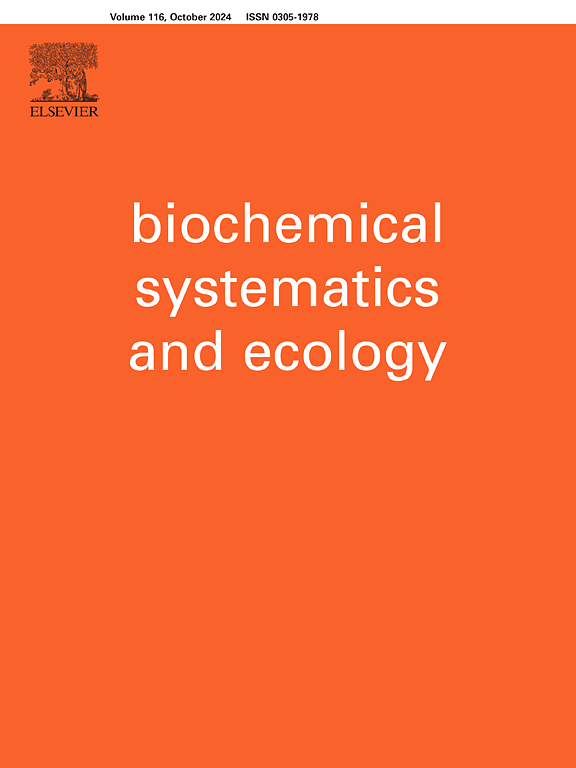海藻土中化学成分的化学分类意义
IF 2
4区 生物学
Q4 BIOCHEMISTRY & MOLECULAR BIOLOGY
引用次数: 0
摘要
通过对 Ligia exotica 进行化学研究,分离出 15 种化合物,包括一种环状三肽(1)、八种环状二肽(2-8)、四种生物碱(9-12)、两种氨基酸(13-14)和一种对羟基苯甲醛(15)。通过核磁共振光谱数据以及与以前报告的数据进行比较,确定了这些化合物的结构。化合物 1-2 和 10-11 是首次从海蛞蝓中鉴定出来的,其中有五个化合物(1、2、10-12)以前从未从蛞蝓属和蛞蝓科中分离出来过。化合物 1 对 22Rv1 和 PC-3 细胞具有很强的抗前列腺癌活性。本研究还讨论了这些分离化合物的化学分类学意义。本文章由计算机程序翻译,如有差异,请以英文原文为准。
Chemotaxonomic significance of chemical constituents from Ligia exotica, sea slater
Chemical investigation of Ligia exotica resulted in the isolation of 15 compounds, including one cyclic tripeptide (1), eight cyclic dipeptides (2–8), four alkaloids (9–12), two amino acids (13–14) and a p-hydroxy benzaldehyde (15). Their structures were identified by NMR spectroscopic data and comparison with previously reported data. Compounds 1–2, and 10–11 were identified from the sea slater for the first time, and five compounds (1, 2,10–12) have not previously been isolated from the genus Ligia and the family Ligiidae. Compound 1 exhibited potent anti-prostate cancer activity against 22Rv1 and PC-3 cells. This study also discussed the chemotaxonomic significance of these isolated compounds.
求助全文
通过发布文献求助,成功后即可免费获取论文全文。
去求助
来源期刊

Biochemical Systematics and Ecology
生物-进化生物学
CiteScore
3.00
自引率
12.50%
发文量
147
审稿时长
43 days
期刊介绍:
Biochemical Systematics and Ecology is devoted to the publication of original papers and reviews, both submitted and invited, in two subject areas: I) the application of biochemistry to problems relating to systematic biology of organisms (biochemical systematics); II) the role of biochemistry in interactions between organisms or between an organism and its environment (biochemical ecology).
In the Biochemical Systematics subject area, comparative studies of the distribution of (secondary) metabolites within a wider taxon (e.g. genus or family) are welcome. Comparative studies, encompassing multiple accessions of each of the taxa within their distribution are particularly encouraged. Welcome are also studies combining classical chemosystematic studies (such as comparative HPLC-MS or GC-MS investigations) with (macro-) molecular phylogenetic studies. Studies that involve the comparative use of compounds to help differentiate among species such as adulterants or substitutes that illustrate the applied use of chemosystematics are welcome. In contrast, studies solely employing macromolecular phylogenetic techniques (gene sequences, RAPD studies etc.) will be considered out of scope. Discouraged are manuscripts that report known or new compounds from a single source taxon without addressing a systematic hypothesis. Also considered out of scope are studies using outdated and hard to reproduce macromolecular techniques such as RAPDs in combination with standard chemosystematic techniques such as GC-FID and GC-MS.
 求助内容:
求助内容: 应助结果提醒方式:
应助结果提醒方式:


